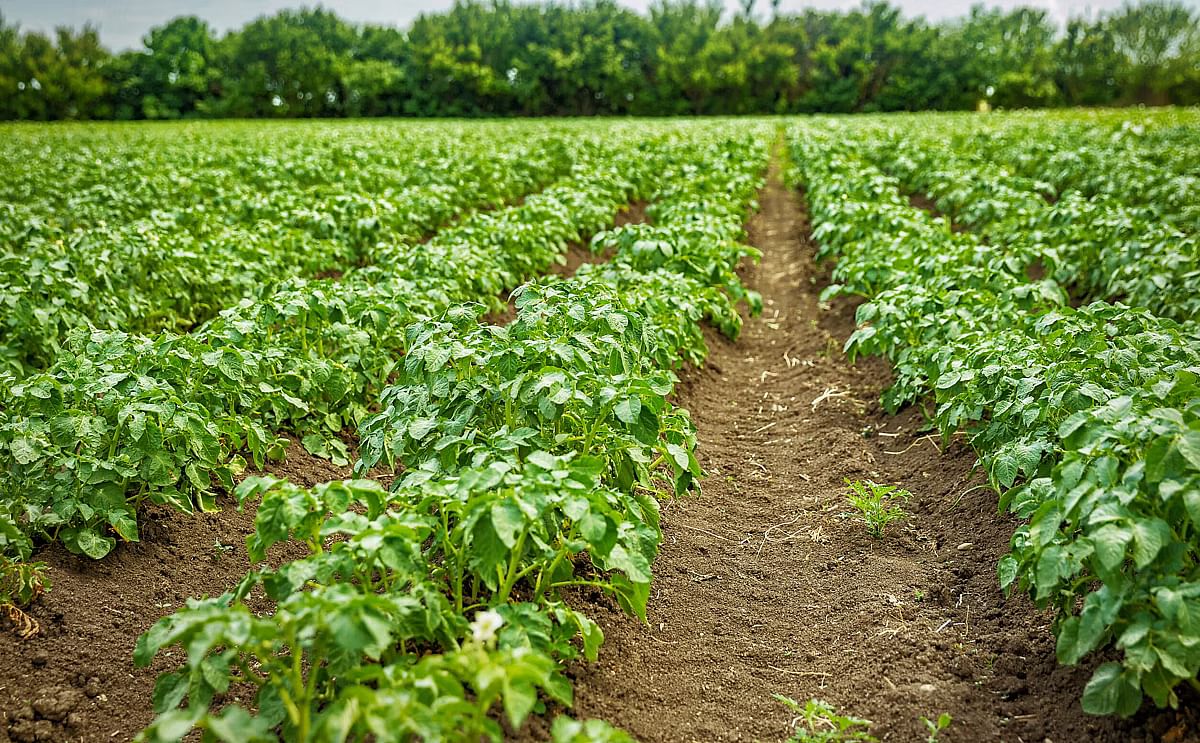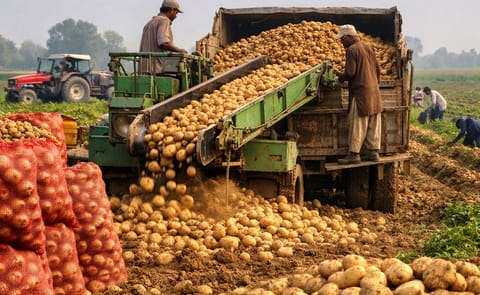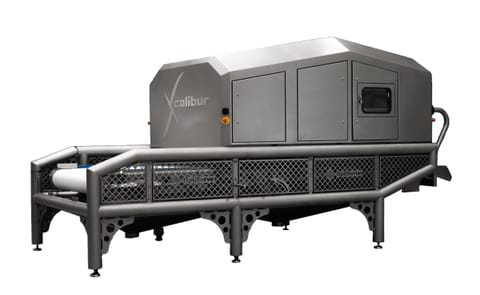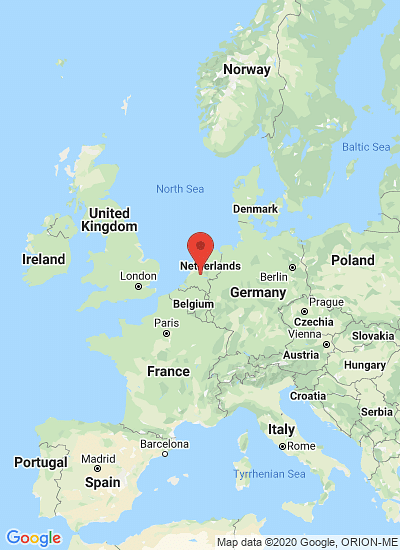Northwestern Europe Potato Growers (NEPG): How will the potato market in North-western Europe develop?
NEPG: How will the potato market in North-western Europe develop?

In Northwestern Europe (EU-04; NL, DE, BE, FR) the potato sector is facing a range of issues in the upcoming months. The million dollar question: How will the potato market respond? An analysis by the North-western European Potato Growers (NEPG).
In view of the current season, the question naturally arises as to how the market will develop further. They hear from various countries that free stocks are limited.
In the Netherlands for example, VTA's latest inventory shows that the free stock is 13% lower than last season and no less than 20% lower than the 5-year average. The same sounds come from the other NEPG countries. With good demand from the industry, the mood remains positive.
Looking ahead to the next season, the question is already how the hectareage within the NEPG countries will develop. Normally, the sharp increase in contract prices would have a direct impact on the size of the potato area. The fickle grain market, where prices have been somewhat tempered in recent months, also plays a role in this.
An expansion of the potato area (due to an historical rise in contract prices) of a few percents seems the most likely scenario under these circumstances. Whether this will actually happen remains to be seen.
There does not seem to be much room in the potato area for structural expansion in the Netherlands and Belgium due to a lack of (new) potato land, the new CAP, the greening agreements linked to the Green Deal that must be fulfilled and the increased prices for land rent.
Shift of hectareage
Expansion in the Netherlands must largely be achieved at the expense of the starch or seed potato area. In the traditional clay growing areas, growers seem to prefer the highest possible contracted tonnage, but not in a clear expansion. Within the NEPG zone (EU-4), there are opportunities in the north of Germany due to a shift from table and starch potatoes to chipping (french fries) potatoes.
The disadvantage in this region remains the distance to the epicenter of the processing capacity, which is located in the south of the Netherlands and in Belgium. In addition, competition must be entered into with other crops that have performed well in the past year. In France, too, the hectareage gain will have to come from the switch from seed and table potatoes to chipping varieties.
In addition, in France and Germany not all areas are suitable for intensive potato cultivation due to lack of irrigation options. New legislation in Belgium, be it linked to nitrogen use or a potato cultivation ban (among other crops on ridges, maize,…) in zones with high erosion risks on thousands ha of land could reduce potato area in the coming years.
Concerns about seed production this season and seed availability in spring 2024
The NEPG zone (and other seed producing countries like Denmark and Scotland) could lose at least 5.000 ha (and maybe more) of seed production.
This reduction is mainly due to a switch from seed production to more area for processing varieties due mainly to low profitability in the seed sector, and also new constraints regarding tougher legislation on pesticide use.
Ware growers are concerned about security of seed availability and risk of higher prices. Processors need more potato land and production, but to feed the industry, ware growers need enough seed…
Low water reserves and drought still plays a role
At the same time, the water supply is a point of attention, especially in the southern regions of the NEPG zone. Drought risk is of growing concern. The consequences of last summer's extreme drought are still affecting water resources.
There are large regional and country differences, but moisture reserves are still low (albeit some rainfall during the last fortnight), especially in (potato) regions more to the south of our zone. The industry reports that the need for raw materials has already been largely met.
If the hectareage increases and the harvest is above average, this could have major consequences for the free market. Due to the high coverage ratio of the industry, a scenario is conceivable that there will be little buying interest and or market forces for the free potatoes.
In view of the current season, the question naturally arises as to how the market will develop further. They hear from various countries that free stocks are limited.
In the Netherlands for example, VTA's latest inventory shows that the free stock is 13% lower than last season and no less than 20% lower than the 5-year average. The same sounds come from the other NEPG countries. With good demand from the industry, the mood remains positive.
Looking ahead to the next season, the question is already how the hectareage within the NEPG countries will develop. Normally, the sharp increase in contract prices would have a direct impact on the size of the potato area. The fickle grain market, where prices have been somewhat tempered in recent months, also plays a role in this.
An expansion of the potato area (due to an historical rise in contract prices) of a few percents seems the most likely scenario under these circumstances. Whether this will actually happen remains to be seen.
There does not seem to be much room in the potato area for structural expansion in the Netherlands and Belgium due to a lack of (new) potato land, the new CAP, the greening agreements linked to the Green Deal that must be fulfilled and the increased prices for land rent.
Shift of hectareage
Expansion in the Netherlands must largely be achieved at the expense of the starch or seed potato area. In the traditional clay growing areas, growers seem to prefer the highest possible contracted tonnage, but not in a clear expansion. Within the NEPG zone (EU-4), there are opportunities in the north of Germany due to a shift from table and starch potatoes to chipping (french fries) potatoes.
The disadvantage in this region remains the distance to the epicenter of the processing capacity, which is located in the south of the Netherlands and in Belgium. In addition, competition must be entered into with other crops that have performed well in the past year. In France, too, the hectareage gain will have to come from the switch from seed and table potatoes to chipping varieties.
In addition, in France and Germany not all areas are suitable for intensive potato cultivation due to lack of irrigation options. New legislation in Belgium, be it linked to nitrogen use or a potato cultivation ban (among other crops on ridges, maize,…) in zones with high erosion risks on thousands ha of land could reduce potato area in the coming years.
Concerns about seed production this season and seed availability in spring 2024
The NEPG zone (and other seed producing countries like Denmark and Scotland) could lose at least 5.000 ha (and maybe more) of seed production.
This reduction is mainly due to a switch from seed production to more area for processing varieties due mainly to low profitability in the seed sector, and also new constraints regarding tougher legislation on pesticide use.
Ware growers are concerned about security of seed availability and risk of higher prices. Processors need more potato land and production, but to feed the industry, ware growers need enough seed…
Low water reserves and drought still plays a role
At the same time, the water supply is a point of attention, especially in the southern regions of the NEPG zone. Drought risk is of growing concern. The consequences of last summer's extreme drought are still affecting water resources.
There are large regional and country differences, but moisture reserves are still low (albeit some rainfall during the last fortnight), especially in (potato) regions more to the south of our zone. The industry reports that the need for raw materials has already been largely met.
If the hectareage increases and the harvest is above average, this could have major consequences for the free market. Due to the high coverage ratio of the industry, a scenario is conceivable that there will be little buying interest and or market forces for the free potatoes.
Like to receive news like this by email? Join and Subscribe!
Get the latest potato industry news straight to your WhatsApp. Join the PotatoPro WhatsApp Community!
Highlighted Company
Sponsored Content
Sponsored Content
Sponsored Content
Sponsored Content








